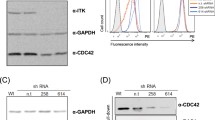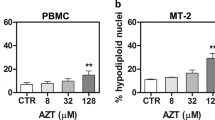Abstract
Background
Replication of HIV-1 in human T lymphocytes requires the activation of host cellular proteins. This study identifies p38 mitogen-activated protein kinase (MAPK) as one such kinase necessary for HIV-1 replication in T cells.
Materials and Methods
Primary human T lymphocytes were infected with the LAI strain of HTV-1 and Jurkat cells were infected with the RF strain of HIV-1. HIV replication was measured by reverse transcriptase activity. Cellular expression of endogenous p38 MAPK protein was analyzed using immunoprecipitation. Blockade of p38 MAPK expression was achieved using anti-sense oligonucleotides to p38 MAPK and the guanylhydrazone compound CNI-1493, an inhibitor of p38 MAPK activation.
Results
HTV-1 infection of both primary human T lymphocytes and a T cell line rapidly activated the cellular p38 MAPK pathway, which remained activated for the duration of the culture. Addition of phosphothioated antisense oligonucleotides to p38 MAPK specifically inhibited viral replication. Blockade of p38 MAPK activation by addition of CNI-1493 also inhibited HIV-1 viral replication of primary T lymphocytes in a dose- and time-dependent manner. Stimulation of p38 MAPK activation did not occur with the addition of heat-inactivated virus, suggesting that viral internalization, and not just membrane binding, is necessary for p38 MAPK activation.
Conclusions
These results indicate that activation of the p38 MAPK cascade is critical for HIV-1 replication in primary T lymphocytes, and that blockade of this signal transduction pathway may be a novel therapeutic approach to the treatment of HIV-1 infection.



Similar content being viewed by others
References
Collier AC, Coombs RW, Schoenfeld DA, et al. (1996) Treatment of human immunodeficiency virus infection with saquinavir, zidovudine, and zalcitabine. AIDS Clinical Trials Group. N. Engl. J. Med. 334: 1011–1017.
Eron JJ, Benoit SL, Jemsek J, et al. (1995) Treatment with lamivudine, zidovudine, or both in HIV-positive patients with 200 to 500 CD4+ cells per cubic millimeter. North American HIV Working Party [see comments]. N. Engl. J. Med. 333: 1662–1669.
Deeks S, Volberding P. (1995) An approach to antiretroviral treatment of HIV disease. Combined antiretroviral therapy: the emerging role. Hosp. Tract. (Off. Ed). 30(Suppl 1): 23–31.
Fauci AS, Pantaleo G, Stanley S, Weissman D. (1996) Immunopathogenic mechanisms of HIV infection. Ann. Intern. Med. 124: 654–663.
Heguy A, Stewart AA, Haley JD, Smith DE, Foulkes JG. (1995) Gene expression as a target for new drug discovery. Gene Expr. 4: 337–344.
Duh EJ, Maury WJ, Folks TM, Fauci AS, Rabson AB. (1989) Tumor necrosis factor alpha activates human immunodeficiency virus type 1 through induction of nuclear factor binding to the NF-kappa B sites in the long terminal repeat. Proc. Natl. Acad. Sci. U.S.A. 86: 5974–5978.
Osborn L, Kunkel S, Nabel GJ. (1989) Tumor necrosis factor alpha and interleukin 1 stimulate the human immunodeficiency virus enhancer by activation of the nuclear factor kappa B. Proc. Natl. Acad. Sci. U.S.A. 86: 2336–2340.
Han J, Lee J-D, Bibbs L, Ulevitch RJ. (1994) A MAP kinase targeted by endotoxin and hyperosmolarity in mammalian cells. Science 265: 808–811.
Lee JC, Laydon JT, McDonnell PC, et al. (1994) A protein kinase involved in the regulation of inflammatory cytokine biosynthesis. Nature 372: 739–746.
Raingeaud J, Gupta S, Rogers JS, et al. (1995) Pro-inflammatory cytokines and environmental stress cause p38 mitogen-activated protein kinase activation by dual phosphorylation on tyrosine and threonine. J. Biol. Chem. 270: 7420–7426.
Shapiro L, Dinarello CA. (1996) Specific inhibition of p38 mitogen activated protein (MAP) kinase inhibits in vitro HIV replication in Ul cells induced by interleukin (IL)-l, tumor necrosis factor (TNF) or phor-bol esters (PMA). Eur. Cytokine Netw. 7(3): 557.
Kumar S, Orsini M, Lee J, McDonnell P, Debouck C, Young P. (1996) Activation of the HIV LTR by UV, cytokines and high os-molarity requires CSBP/p38 activation. Eur. Cytokine Netw. 7(3): 558.
Sen J, Kapeller R, Fragoso R, Sen R, Zon LI, Burakoff SJ. (1996) Intrathymic signals in thymocytes are mediated by p38 mitogen-activated protein kinase. J. Immunol. 156: 4535–4538.
Han J, Richter B, Li Z, Kravchenko V, Ulevitch RJ. (1995) Molecular cloning of human p38 MAP kinase. Biochim. Biophys. Acta 1265: 224–227.
Bianchi M, Ulrich P, Bloom O, et al. (1995) An inhibitor of macrophage arginine transport and nitric oxide production (CNI-1493) prevents acute inflammation and endotoxin lethality. Mol. Med. 1: 254–266.
Bianchi M, Bloom O, Raabe T, et al. (1995) Suppression of proinflammatory cytokines in monocytes by a tetravalent guanylhydrazone. J. Exp. Med. 183: 927–936.
Cohen PS, Nakshatri H, Dennis J, et al. (1996) CNI-1493 inhibits monocyte/macrophage tumor necrosis factor by suppression of translation efficiency. Proc. Natl. Acad. Sci. U.S.A. 93: 3967–3971.
Kumar S, Orsini MJ, Lee JC, McDonnell PC, Debouck C, Young PR. (1996) Activation of the HIV-1 long terminal repeat by cytokines and environmental stress requires an active CSBP/p38 MAP kinase. J. Biol. Chem. (In Press).
Lu X, Wu X, Plemenitas A, et al. (1996) CDC42 and Racl are implicated in the activation of the Nef-associated kinase and replication of HIV-1. Curr. Biol. 6: 1677–1684.
Nunn MF, Marsh JW. (1997) Human immunodeficiency virus type 1 NEF associates with a member of the p21-activated kinase family. J. Virol. 70: 6157–6161.
Sawai ET, Khan IH, Montbriand PM, et al. (1996) Activation of PAK by HIV and SIV Nef: Importance for IADS in Rhesus macaque. Curr. Biol. 6: 1519–1527.
Batchvarova N, Wang XZ, Ron D. (1995) Inhibition of adipogenesis by the stress-induced protein CHOP (Gadd 153). EMBO J. 14: 4654–4661.
Freshney NW, Rawlinson L, Guesdon F, et al. (1994) Interleukin-1 activates a novel protein kinase cascade that results in the phosphorylation of Hsp27. Cell 78: 1039–1049.
Zervos AS, Faccio L, Gatto JP, Kyriakis JM, Brent R. (1995) Mxi2, a mitogen-activated protein kinase that recognizes and phos-phorylates Max protein. Proc. Natl. Acad. Sci. U.S.A. 92: 10531–10534.
Trono D. (1995) HIV accessory proteins: Leading roles for the supporting cast. Cell 82: 189–192.
Yang X, Goncalves J, Gabuzda D. (1996) Phosphorylation of Vif and its role in HIV-1 replication. J. Biol. Chem. 271: 10121–10129.
Heinzinger NK, Bukinsky MI, Haggerty SA, et al. (1994) The Vpr protein of human immunodeficiency virus type 1 influences nuclear localization of viral nucleic acids in nondividing host cells. Proc. Natl Acad. Sci. U.S.A. 91: 7311–7315.
Xia Z, Dickens M, Raingeaud J, Davis RJ, Greenberg ME. (1995) Opposing effects of ERK and JNK-p38 MAP kinases on apoptosis. Science 270: 1326–1331.
Flory E, Hoffmeyer A, Smola U, Rapp UR, Bruder JT. (1996) Raf-1 kinase targets GA-binding protein in transcriptional regulation of the human immunodeficiency virus type 1 promoter. J. Virol 70: 2260–2268.
Kaplan G, Moreira AL. (1994) TNF alpha regulation of HIV1: Biology and therapy. Res. Immunol 145: 685–689.
Acknowledgments
We thank Ms. Dee Prieto for excellent secretarial support. Part of this work was presented at the meeting Molecular Basis of Sepsis, October 8–11, 1996, at Woods Hole, MA. This work was supported by NIH grants DK49283 and NIH A138245 and by institutional funding from The Picower Institute for Medical Research.
Author information
Authors and Affiliations
Corresponding author
Additional information
Communicated by R. Bucala.
Rights and permissions
About this article
Cite this article
Cohen, P.S., Schmidtmayerova, H., Dennis, J. et al. The Critical Role of p38 MAP Kinase in T Cell HIV-1 Replication. Mol Med 3, 339–346 (1997). https://doi.org/10.1007/BF03401812
Accepted:
Published:
Issue Date:
DOI: https://doi.org/10.1007/BF03401812




